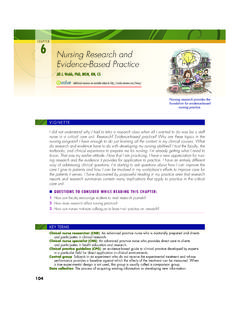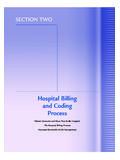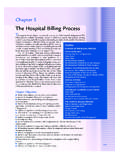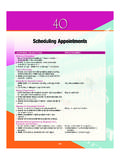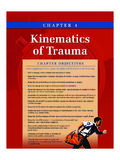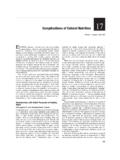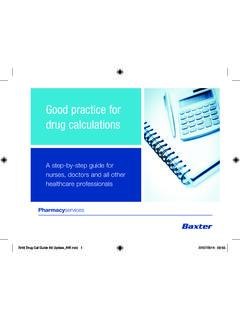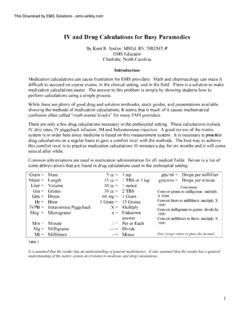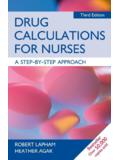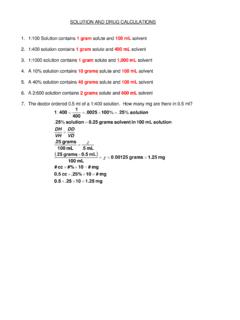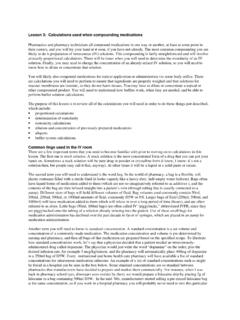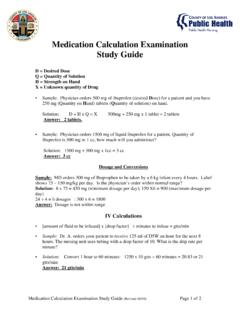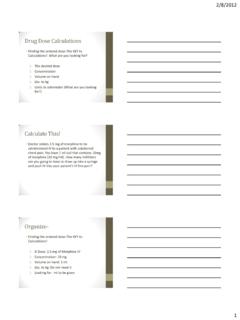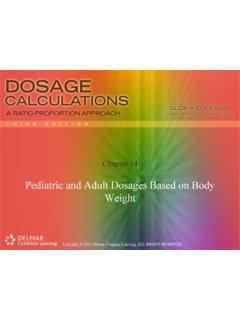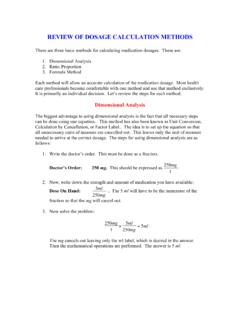Transcription of Pediatric Dosages - Coursewareobjects.com
1 Copyright 2012 Mosby, Inc, an affiliate of Elsevier, Inc, All rights Dosages CHAPTER 18 CHAPTER 18 LEARNING OBJECTIVES409 Pediatric Dosages 1 Converting the weight of a child from pounds to kilograms 2 Converting the neonate and infant weight from grams to kilograms 3 Performing Pediatric dosage calculations 4 Calculating the single or individual dose of medications 5 Determining whether the prescribed dose is safe and therapeutic 6 Calculating a safe and therapeutic 24-hour dosage range 7 Calculating the single dose range from a 24-hour dosage range 8 Determining whether the actual dosage (in milligrams per kilograms per 24 hours) is safe to administer 9 Calculating Pediatric IV solutions 10 Administering IV medications to Pediatric patients 11 Calculating the daily fluid requirements for infants and young children 12 Calculating the body surface area (BSA) for medication administrationChildren are more sensitive than adults to medications because of their weight, height, physical condition, immature systems, and metabolism.
2 Nurses who administer medications to infants and children must be vigilant in determining whether the patient is receiving the correct medication. The correct dose is one of the six rights of drug administration: right patient, medication, route, time, dose, and physician or provider will prescribe the medication to be delivered. However, the nurse is responsible for detecting any errors in calculation of dosage , as well as for preparing the medication and administering the drug . The nurse needs to be aware that Pediatric Dosages are often less than 1 mL; therefore a tuberculin syringe is used for accurate medications are calculated using the infant or child s kilogram weight. The Dosages have been established by the drug companies. Safe and therapeutic (S&T) Dosages are readily available from a reliable source such as The Harriet Lane general, Pediatric Dosages are rounded to the nearest tenth. For infants and young children, doses may be rounded to the nearest hundredth.
3 The child who weighs more than On completion of the materials provided in this chapter, you will be able to perform computations accurately by mastering the following mathematical concepts: ALERTN ever exceed the adult dose or maximum dose recommended.!Ogden 978-0-323-07753-8 40912/7/10 8:18 AM410 CHAPTER 18 Pediatric DosagesCopyright 2012 Mosby, Inc, an affiliate of Elsevier, Inc, All rights kg may receive adult Dosages . If the calculated dose is greater than the recommended adult dose, DO NOT administer the medication. A child should not receive higher doses than those recommended for the adult, ever. Many drugs have a do not exceed or max. dose in 24 hours listed; this must always be , the physician or pharmacist may use the child s body surface area (BSA) to calculate a dosage of medication to administer. The BSA calculation may be used when an established dosage has not been determined by the drug company, as with some anticancer or specialized CONVERSIONSC onverting Pounds to KilogramsThe formula: lb 5 1 kgInfant s and young children s weight in pounds must be converted to kilograms to accurately calculate medication doses and daily fluid requirements.
4 S&T drug Dosages have been established using kilogram round the kilogram weight to the nearest tenth, NOT a whole 1: An infant weighs 24 lb. Convert the infant s weight to Formula lb ; 1 kg < 24 lb ; x ; 1 < 24 ; 5 5 kgExamplE 2: A child weighs 47 lb. Convert the child s weight to lb ; 1 kg < 47 lb ; x ; 1 < 47 ; 5 5 kg or kg (rounded to the nearest tenth)Converting Grams to KilogramsThe formula: 1000 g 5 1 kgNewborn (neonate) and some infant weights are measured in grams. Converting grams to kilograms is done as shown below or by simply dividing the number of grams by 1: A neonate weighs 2300 g. Convert to g ; 1 kg < 2300 g ; x kg1000 ; 1 < 2300 ; x1000x 5 2300 x 5 5 24x 5 5 47x 5 kgOgden 978-0-323-07753-8 41012/7/10 8:19 AM411 Copyright 2012 Mosby, Inc, an affiliate of Elsevier, Inc, All rights Dosages CHAPTER 18 ExamplE 2: A newborn weighs 4630 g at birth. Convert to g ; 1 kg < 4630 g ; x kg1000 ; 1 < 4630 ; x1000x 5 4630 x 5 kg, or (rounded to the nearest tenth)Practice Problems.
5 Convert pounds and grams to 27 lb _____ kg2. 38 lb _____ kg3. 52 lb _____ kg4. 5220 g _____ kg5. 3202 g _____ kg6. 72 lb _____ kg7. 16 lb _____ kg8. 92 lb _____ kgAnswers1. kg 4. kg 7. kg2. kg 5. kg 8. kg3. kg 6. kgPEDIATRIC dosage CALCULATIONSIn Pediatric dosage calculations, you can use a proportion or formula or Formulamg ; mL < mg ; x mL mgmLmgmL3 ExamplE 1: The physician orders Benadryl mg po q4 6 h prn for itching. The nurse has available Benadryl 25 mg/5 mL. How many milliliters would be needed to administer mg? Show mg ; 5 mL < mg ; x mLx 5 mLExamplE 2: The physician orders morphine 15 mg by intravenous (IV) piggyback (IVPB) now. You have available morphine 10 mg/mL. How much would you give? Show mg ; 1 mL < 15 mg ; x mLx 5 mLCALCULATING THE SINGLE OR INDIVIDUAL DOSE (MILLIGRAMS/DOSE)Medications such as acetaminophen and ibuprofen are administered as a single dose. This means that each time the infant or child receives the medication, it is calculated in a single or individual dose based on the kilogram of the medications prescribed in this manner are prn medications, which are given as needed for relief of symptoms such as pain, nausea, and fever.
6 Again, the manufacturer of the drug 5 mL10mg1mL15mgmL3xx 5 mLOgden 978-0-323-07753-8 41112/7/10 8:19 AM412 CHAPTER 18 Pediatric DosagesCopyright 2012 Mosby, Inc, an affiliate of Elsevier, Inc, All rights established an S&T dosage or range. The nurse is responsible for administering the single dose that is S&T. Therefore it is helpful for the nurse to know how the ordered dose is determine the correct single dose for the child, you must calculate the correct dose. A systematic approach is helpful in determining the S&T dose range: Change the child s weight in pounds to kilograms. Find the recommended dosage in a reliable source. Multiply the kilogram weight by the recommended dose(s). The answer is the individual or single dose (mg/dose) of medication to be given each time the child receives the 1: A child weighs 22 lb. The child needs acetaminophen for pain and fever. a. Weight 22 lb 5 10 kg b. Recommended 10 to 15 mg/kg/dose q4 6 h c.
7 Calculation10 mg ; 1 kg < x mg ; 10 kg 15 mg ; 1 kg < x mg ; 10 kg10 ; 1 < x ; 10 15 ; 1 < x ; 10x 5 100 mg/dose x 5 150 mg/dose The child may receive 100 to 150 mg each time he or she is given acetaminophen. This is the single or individual dose. The dose is both safe and therapeutic for this child. A dose smaller than 100 mg is considered safe but may not be therapeutic for the child s weight. Doses larger than 150 mg are considered too much for the child s weight and may exceed the therapeutic range. There are exceptions some Dosages may be higher. Check the Hariett Lane Handbook or other Pediatric dosing 2: Calculate an S&T dose range of ibuprofen for a child who weighs 36 lb. Ibuprofen is available as 100 mg/5 mL. How many milliliters would you need to administer for the ordered dose to be S&T? a. Weight 36 lb 5 kg b. Recommended 5 to 10 mg/kg/dose q6 8 h c. Calculations5 mg ; 1 kg < x mg ; kg 10 mg ; 1 kg < x mg ; ; 1 < x ; 10 ; 1 < x ; 5 82 mg/dose x 5 164 mg/doseThe S&T single dose range for this child is 82 to 164 mg/dose.
8 D. Now perform dosage calculations for the single dose range using the 100 mg/5 mL strength:100 mg ; 5 mL < 82 mg ; x mL 100 mg ; 5 mL < 164 mg ; x mLx 5 mL x 5 mL ALERTA cetaminophen:Never give more than 5 doses in 24 hours to the infant or young exceed 4000 mg/day (4 grams) for the older child and parents or caregiver.!Ogden 978-0-323-07753-8 41212/7/10 8:19 AM413 Copyright 2012 Mosby, Inc, an affiliate of Elsevier, Inc, All rights Dosages CHAPTER 18 DETERMINE WHETHER THE PRESCRIBED DOSE IS SAFE AND THERAPEUTIC (MILLIGRAMS/KILOGRAM/DOSE)This method will determine whether the child is receiving an S&T dosage of the drug that is prescribed by the physician. The nurse must determine whether the ordered dose is within the recommended though the physician has prescribed the medication to be given, it is the nurse s responsibility to determine whether the dose is S&T to administer to the child. This is done by dividing the ordered dosage by the child s weight in kilograms (mg/kg/dose).
9 A systematic approach is needed. Obtain the child s weight in kilograms. Obtain the ordered dosage . Divide the ordered dose by the child s weight. The answer is the mg/kg/dose (for each dose administered). Check your drug book to determine whether the ordered dose is S&T (in the recommended dosage range).ExamplE: The doctor has ordered 210 mg of acetaminophen q4 6 h for pain and fever for a postoperative child. The child weighs 39 lb. The recommended dose range for acetaminophen is 10 to 15 mg/kg/dose q4 6 h. Acetaminophen is supplied as 160 mg/5 mL. Is the ordered dose S&T to administer? If the dose ordered is S&T to administer, how many milliliters will be needed? a. Weight 39 lb 5 kg b. Ordered 210 mg q4 6 h c. calculation 210 d. Recommended 10 to 15 mg/kg/dose The patient will receive mg/kg/dose. Yes, it is safe to administer the aceta minophen because it is within the S&T dosage range of 10 to 15 mg/kg/dose. e. Perform dosage calculation using 160 mg/5 mL concentration:160 mg ; 5 mL < 210 mg ; x mL160x 5 1050x 5 mL rounded to the nearest tenthRemember to round all doses to the nearest : Round all narcotics, antiepileptics, and cardiac medications to nearest hundredth.
10 Medications that may be rounded to the nearest hundredth include phenobarbital, morphine, dilantin, digoxin, and anticancer THE 24-HOUR dosage (RANGES)Many drugs are calculated based on the recommended 24-hour dose, then divided into single doses to be given every 12, 8, 6, or 4 hours or as recommended by the drug manufacturers. These divided time schedules vary, and the physician, nurse practitioner, or physician s assistant will order the medication based on the recommended especially are given this way. Additionally, an antibiotic may be given in Dosages or ranges that have been found to be effective for the child s diagnosis. The physician chooses how often the medication is to be delivered. An example of an antibiotic with many dosing choices is 978-0-323-07753-8 41312/7/10 8:19 AM414 CHAPTER 18 Pediatric DosagesCopyright 2012 Mosby, Inc, an affiliate of Elsevier, Inc, All rights Dosages for ampicillin may be any of the following:,2 kg 50 to 100 mg/kg/24 h/q8 kg 100 to 200 mg/kg/24 h/q8 hMild to moderate infection 100 to 200 mg/kg/24 h/q6 hSevere infection 200 to 400 mg/kg/24 h/q4 6 hThe physician must determine the dosage to be given to the infant or child.
